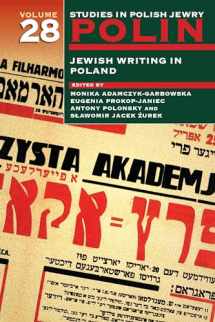
Polin: Studies in Polish Jewry Volume 28: Jewish Writing in Poland (Polin: Studies in Polish Jewry, 28)
ISBN-13:
9781906764463
ISBN-10:
1906764468
Edition:
Bilingual
Author:
Antony Polonsky, Monika Adamczyk-Garbowska, Slawomir Jacek Zurek, Eugenia Prokop-Janiec
Publication date:
2016
Publisher:
The Littman Library of Jewish Civilization
Format:
Paperback
596 pages
FREE US shipping
Book details
ISBN-13:
9781906764463
ISBN-10:
1906764468
Edition:
Bilingual
Author:
Antony Polonsky, Monika Adamczyk-Garbowska, Slawomir Jacek Zurek, Eugenia Prokop-Janiec
Publication date:
2016
Publisher:
The Littman Library of Jewish Civilization
Format:
Paperback
596 pages
Summary
Polin: Studies in Polish Jewry Volume 28: Jewish Writing in Poland (Polin: Studies in Polish Jewry, 28) (ISBN-13: 9781906764463 and ISBN-10: 1906764468), written by authors
Antony Polonsky, Monika Adamczyk-Garbowska, Slawomir Jacek Zurek, Eugenia Prokop-Janiec, was published by The Littman Library of Jewish Civilization in 2016.
With an overall rating of 4.5 stars, it's a notable title among other
books. You can easily purchase or rent Polin: Studies in Polish Jewry Volume 28: Jewish Writing in Poland (Polin: Studies in Polish Jewry, 28) (Paperback) from BooksRun,
along with many other new and used
books
and textbooks.
And, if you're looking to sell your copy, our current buyback offer is $0.3.
Description
Since the Enlightenment, the cultural creativity of Polish Jews has found expression not only in Hebrew and Yiddish, but increasingly in Polish. There has been mutual and dynamic interaction between the cultural systems, but, until the end of communism, the trilingual Jewish culture of Poland was little studied. In this volume, scholars from Poland, the United States, Israel, Italy, and Argentina investigate writers from across this spectrum and consider how they saw their Jewish (and sometimes Polish) identity, and what they thought of the authors in the other linguistic or cultural camps. Together, their essays constitute the first examination of Jewish literatures in Poland from the point of view of both linguistic and geographical diversity. The interwar years serve as the reference point, but material on the period before World War I and after 1945 is also included. The book comprises six sections. There is new research on Jewish literature in Polish, including discussions of less widely known works by Janusz Korczak and Julian Stryjkowski. Polish-Yiddish-Hebrew literary contacts are then reviewed, with important pieces on Y.L. Peretz's early work, the translation of Hayim Nahman Bialik's poetry into Polish, the influence of Polish writers on Sholem Asch's early plays, and the reception of Yosef Opatoshu's novels in interwar Poland. The next section explores the images of Poles and Poland in the work of Jewish writers and of Jews in the work of Polish authors, for instance in the work of the Hebrew Nobel laureate S.Y. Agnon and the Polish writer Stanislaw Vincenz. The subsequent section looks at avant-garde art and modern ideologies, with discussions of Bruno Schulz's graphic works and why communism appealed to some Jewish writers. Discussion then moves to questions of identity, with a special focus on Julian Tuwim, one of the greatest Polish poets, an assimilated Jew attacked by Polish nationalists on the one hand and Yiddishists on the other. The last group of essays in the collection looks at different 'exiles,' understood both literally and metaphorically and encompassing works created in Poland, Israel, and Argentina. In spite of this wide range of themes, the coverage of the topic is not exhaustive: there are still very few studies of Polish-Hebrew literary contacts, and although more has been written about Yiddish writers in Poland there are still areas requiring a comparative perspective. This is a major study of topics which have rarely been discussed in English, especially Jewish literature written in Polish. The articles should appeal to all students of literature, and particularly to those interested in Polish, Yiddish, and Hebrew creativity understood as a rich cultural polysystem. [Subject: History, Jewish Studies, Polish Studies, Literary Studies]


We would LOVE it if you could help us and other readers by reviewing the book
Book review

Congratulations! We have received your book review.
{user}
{createdAt}
by {truncated_author}


